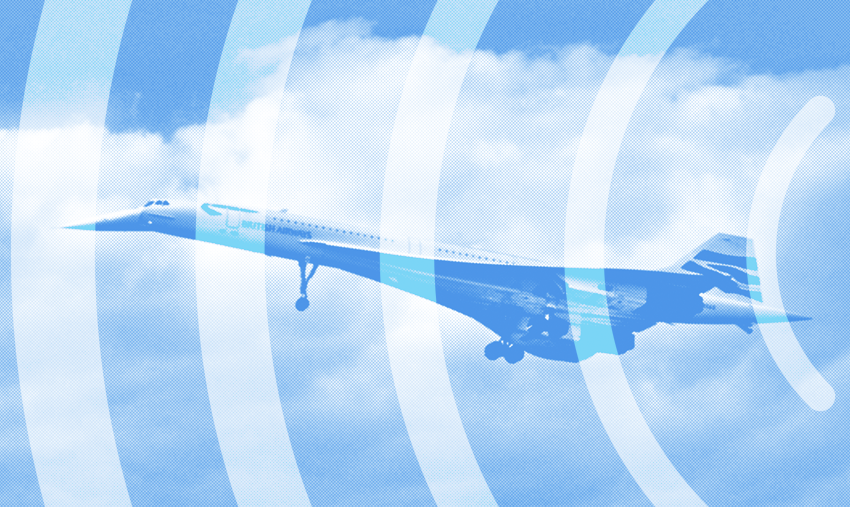Boom and Bust
Twenty years after Concorde, SSTs could soon take flight once more

On October 24, 2003, the supersonic Concorde jet took its final journey from New York to London, carrying 100 passengers. There was much publicity and fanfare around its last trip—the plane was greeted by a large crowd gathered in London at the end of its final leg.
It has been decades since the Concorde’s last flight – two, to be precise – and yet, we seem to only be using advances in materials, engineering, and technology for space travel and building tunnels to nowhere (we’re talking to you, Elon). In unprecedented times of global travel, shouldn’t we be discussing using our human innovation to build aircraft that can get us to more places, faster?
The fastest race near earth
The original development of supersonic jets was supposed to revolutionize the future of air travel. It didn’t quite work out as planned.
In 1962, the race was on to develop the world’s first passenger supersonic jet. That year, the British and French signed a treaty to work on the project together (Yay! Finally, after fighting 41 wars against each other). The Americans were in, and then quickly out of the race with the failed Boeing 2707, their attempt at a supersonic passenger airliner that could carry 300 passengers flying at speeds nearing Mach 3. (A Mach number refers to the ratio of the velocity of an object relative to the speed of sound, i.e., 767 mph. Most commercial aircraft fly at a transonic speed of between Mach 0.8 and 0.88.)
With the USSR and the French/English “teams” still in the running for supersonic supremacy, development was soon mired in espionage allegations: when the Soviet TU-144 took flight at Mach 2.2 on Dec. 31, 1969, three months before the scheduled test flight of the Concorde, it looked so much like the Concorde that the Western press dubbed it the “Conkordski.” (Burn.)
In June 1973, the Concorde and TU-144 were tested head-to-head in front of 200,000 spectators at the Paris Air Show. The Concorde had a perfect run, but the Soviets’ plane, not so much—it broke apart in midair and crashed, killing 14. Concorde passenger flights began in January 1976; the the TU-144 went on 100 domestic flights in the USSR before it was discontinued.
But even after the big win, the reception of the Concorde was lukewarm. People complained about the noise pollution caused by the loud engines and sonic booms that come with the territory of flying around at Mach 2. Most airlines didn’t want to take a chance on the aircraft—just 16 Concordes were built for Air France and British Airways. Eventually, service on the Concordes was only made available between Paris and New York and London and New York.
The beginning of the end of the Concorde was the devastating crash that led to the deaths of all 109 people on board on July 25, 2000. Though it was the only fatal accident in the 27-year history of the plane, it led to costly mandated modifications – and the very first post-crash flight landed in New York on the morning of Sept. 11, 2001, after which they had a harder time selling $12,000 round trip tickets to recoup the investment.
Return of the supersonics
Since the retirement of the Concorde, advancements in aviation technology have been quiet when compared to the buzz surrounding rocket and space travel. Interesting indeed, especially given that space travel is limited to the few, while air travel serves the many.
But, it turns out that there are some big developments in aviation on the horizon.
Boom Supersonic, a US-based company is developing several supersonic jets, including the Overture and the XB-1, with a focus on speed, sustainability, efficiency, and lower noise levels (and they look cool too!) They are getting thisclose to the debut flight of their XB-1 jet which will take place over the Mojave desert, where Chuck Yeager first broke the sound barrier in 1947.
Meanwhile, Spike Aerospace is “delivering the world in half the time” with its S-512 Supersonic Jet. And of course, Richard Branson is also dabbling in high-speed travel with the development of a supersonic jet for 9 to 19 passengers that can reach Mach 3—a whopping three times faster than the speed of sound. (The two other of the three space race amEGOs—Musk and Bezos—seem to be working on supersonic somethings-or-others too.)
Finally, NASA and Lockheed Martin are collecting data using their X-59 supersonic jet to solve the sonic boom problem. They hope to be able to develop technology that can solve the noise issues that have led to a 50-year ban on supersonic travel over land (hence Concorde’s exclusively transatlantic routes).
But for now, if you wanna see a supersonic jet, you’ll have to settle for the Concordes on display at museums around the world.
